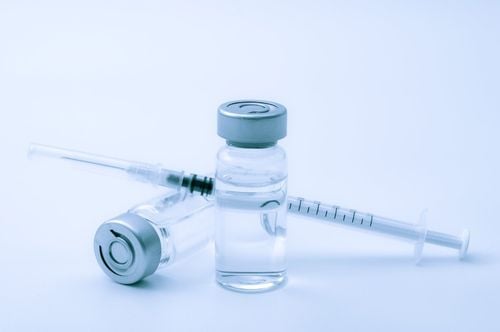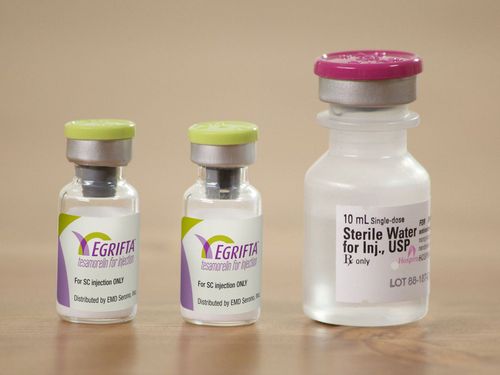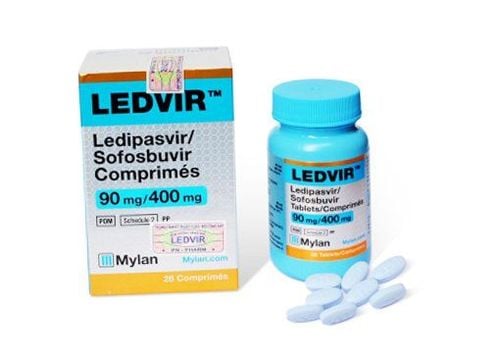This is an automatically translated article.
Pilafix is an antiparasitic, antiviral, anti-infective and anti-fungal drug. Complying with the indications, the dose of Pilafix will help patients improve the effectiveness of treatment and avoid unwanted side effects.
1. What does Pilafix do?
Pilafix medicine contains the main ingredient Lamivudine, 100mg, in the form of long film-coated tablets, packaged in a box of 2 blisters x 15 tablets.
Pharmacodynamics:
The active ingredient Lamivudine in Pilafix is antiretroviral, belonging to the dideoxynucleoside group, inhibiting viral reverse transcriptase. Lamivudine's 5'-triphosphate metabolite, structurally similar to deoxycytidine triphosphate, is a natural substrate for reverse transcriptase. Pilafix has competitive activity with natural deoxycytidine triphosphate for incorporation into viral DNA by reverse transcriptase, causing premature termination of viral DNA synthesis. Lamivudine is active against HIV viruses type 1 and 2 (HIV-1, HIV-2), and also inhibits hepatitis B virus in chronic patients. Pharmacokinetics:
After oral administration, Lamivudine is rapidly absorbed with a bioavailability of about 80%. The mean plasma elimination half-life is 2.5 hours and about 70% of the dose is excreted unchanged in the urine. Pilafix is indicated for the treatment of chronic hepatitis B cases with evidence of hepatitis B virus (HBV) replication with 1 or more of the following conditions:
Liver enzymes serum ALT 2 times higher than normal; Compensated or decompensated cirrhosis; Inflammatory necrotizing liver disease biopsied; Immunodeficiency ; Liver transplant; Combination in the treatment of HIV infection.
2. Contraindications of Pilafix
Contraindicated to use Pilafix in case the patient is sensitive to the components of the drug.
3. Dosage and how to use Pilafix
How to use: Pilafix is taken orally. The dose of Pilafix is based on the patient's weight and age.
Reference dosage:
Usual dose:
Adults and children over 12 years old: Recommended dose of Pilafix: 100mg x 1 time/day. In patients with a normal immune response when an HBeAg and/or HbsAg seroconversion response occurs, the drug should be discontinued. Children under 12 years: Dose 3mg/kg x 1 time/day. Up to 100mg/day. Patients with renal impairment: Pilafix dose should be reduced. Recommended dose:
Treatment of HIV infection:
Adults and adolescents 16 years of age and older:
Weight ≥ 50kg: 150mg of Pilafix and 300mg of Zidovudine. Drink every 12 hours. Weight < 50 kg: 2mg Pilafix/kg body weight and 4mg Zidovudine/kg body weight. Drink every 12 hours. Teenagers 12 years and older to 16 years old:
Weight ≥ 50kg: 150mg of Pilafix and 300mg of Zidovudine. Drink every 12 hours. Weight < 50 kg: There are not enough data to guide the dose for this group of subjects. Children from 3 months to 12 years:
Dose of 4 mg Lamivudine/kg. Drink every 12 hours. Up to 300mg of Pilafix per day. In patients with renal impairment, the dose should be reduced.
Treatment of chronic hepatitis B:
Adults: Dose 100mg/time/day. Children over 2 years old: Dose 3mg/kg/time. Up to 100mg/day. Patients with renal impairment need to reduce the dose of Pilafix as directed by the physician. Patients with co-infected HIV and hepatitis B virus should take antiretroviral doses of HIV. Note: Pilafix dosage above is for reference only. The specific dose of Pilafix depends on the condition and the progression of the disease. To get the right dose of Pilafix, patients should consult their doctor or healthcare professional.
How to handle missed dose, Pilafix overdose:
In case of forgetting Pilafix dose, it is advisable to supplement as soon as possible. However, if it is almost time for the next dose, skip the missed dose of Pilafix and use a new dose. When using an overdose of Pilafix, the patient should immediately stop the drug and go to the nearest medical facility for timely treatment.
4. Drug interactions
Pilafix may have an interaction reaction if used concurrently with:
Trimethoprim; Sulfamethoxazole drug. To avoid interactions, before being prescribed Pilafix, patients should inform their doctor about all the drugs they are using, including dietary supplements. The doctor will base on that to prescribe the appropriate Pilafix.
5. Pilafix side effects
Pilafix has a high level of safety and is less likely to have unwanted side effects. However, using Pilafix in high doses or for a long time, can cause unwanted effects such as:
Common: Insomnia, headache, irritability, pain, fatigue, dizziness, fever, chills , nausea, depression, diarrhea, abdominal pain, anorexia, dyspepsia, peripheral neuropathy, increased amylase, paresthesia, arthralgia, myalgia, nasal signs and symptoms, rash, cough, neutropenia, increased AST, ALT and anemia. Uncommon: Thrombocytopenia, pancreatitis and hyperbilirubinemia. Patients should stop using Pilafix as soon as they detect the above side effects or other unusual symptoms. At the same time, quickly notify the treating doctor or immediately go to a medical facility for timely treatment.
6. Precautions when using Pilafix
After discontinuing Pilafix, the patient may develop a relapse of chronic hepatitis B. Therefore, periodic clinical monitoring and serum liver function tests should be assessed for a minimum of 4 months for evidence of recurrent viral hepatitis. Pilafix 150 mg twice daily should be maintained in patients with concomitant HIV infection. In children with a history of pancreatitis or with risk factors for the development of pancreatitis, the combination of Pilafix and Zidovudine should be closely monitored. When there are clinical signs, or other laboratory results suggestive of pancreatitis, Pilafix should be discontinued immediately. Patients with impaired renal function, children under 12 years of age and adolescents weighing less than 50 kg should not take a fixed combination product containing lamivudine and zidovudine, as each drug cannot be individually adjusted. Pilafix does not cure HIV infection. As a result, the patient continues to carry the disease due to HIV infection and opportunistic infections, and should be monitored and cared for continuously. Pilafix does not reduce the risk of HIV transmission. Therefore, it is recommended that patients use condoms to protect their sexual partners. Although it is not known whether Pilafix is excreted in human milk. However, there is the potential for undesirable effects from Pilafix in breastfed infants. There is also a high risk of HIV transmission from breastfeeding. Therefore, HIV-infected mothers should not breastfeed. Store Pilafix in a cool, dry place, in an airtight container. Absolutely do not use when Pilafix has signs of discoloration, mold, watery or expired. Above is all information about the drug Pilafix uses and dosage. Patients should carefully read the instructions for use, consult a doctor / pharmacist before use. Absolutely do not buy Pilafix for home treatment on your own because there may be unwanted side effects.













